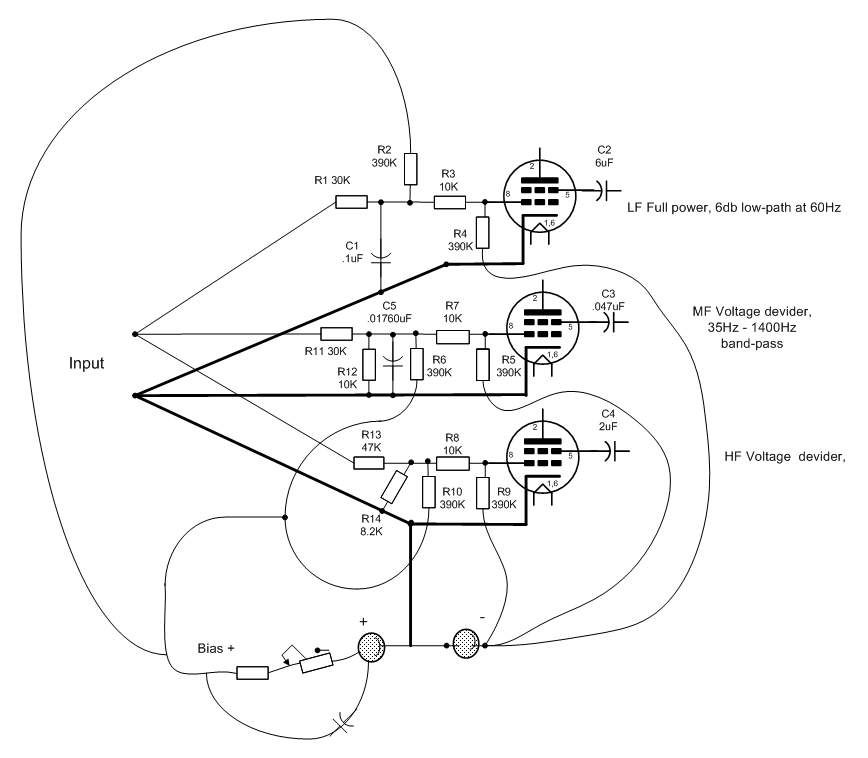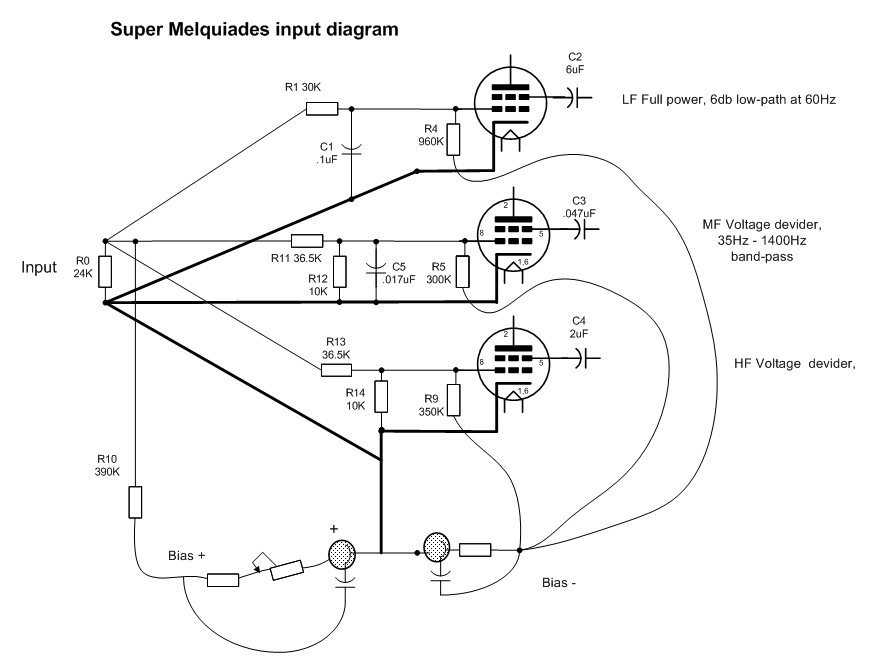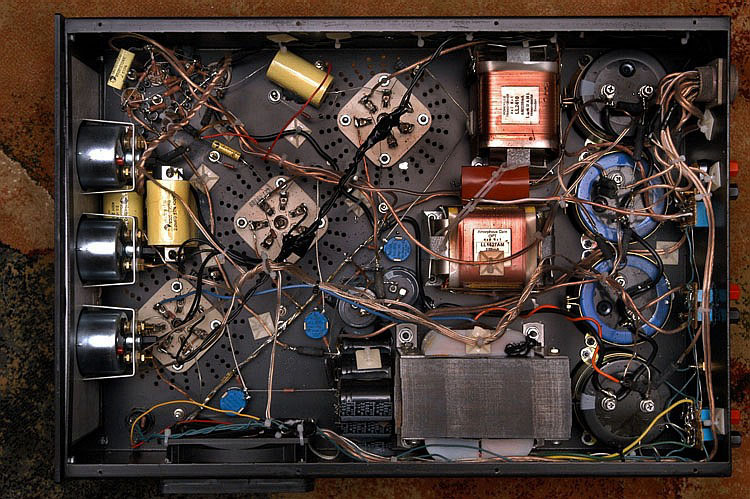Rerurn to Romy the Cat's Site
In the Forum: Melquiades Amplifier
In the Thread: 5 Channel Version of Melquiades
Post Subject: Some thought about 5-Channel Version of MelquiadesPosted by Romy the Cat on: 7/23/2006
This thread is split from the following thread:
http://www.goodsoundclub.com/LatestPosts.aspx?ThreadID=2665
Jessie, I hope you do not mind that I pulled it to the forum explicitly dedicated to the Melquiades Support.
5-channels Melquiades is great idea, I am sorry now that I did not made 4-channels Melquiades as I need now to drive my “Fundamentals Channel” and I do not need one more channel in the same chassis. Still, the 5-channels project would be costly and labor extensive and if I were you I would not dive into it without confirming that a regular single channel Melquiades sound acceptable to you. I would make a prototype with no-chassis and would spend a few months to listen the thing. At that time you will be having you horns and Lamm ML2 and you would be able to observe if Melquiades is valuable to pursue. Who knows, it might be that I’m a fool of it and you did not find the Sound you get from Melquiades worth to continue. A Milq is simple and if you have the Lamm ML2 as a reference (and it is a phenomenal reference!!!) then you would very clearly see if Melquiades is the direction you would like to go. There is another benefit. Since you live on another side of the Globe it is possible that you would like to use some of your local parts and the Milq prototype would be a wonderful opportunity to try some of your choice.
A few words about 5-channels Melquiades that you might to consider. You can pile and many channels as you wish but you have to think in term of packaging everything. Here are some very raw thoughts:
1) You need to decide if you go for single chasses vs. separate chassis for amp and powers supply and if you go for stereo amps vs. monoblocks. I went for dual chasses monoblocks. If you select the same direction then be advised that you must keep that last largest capacitor of each power supply on the amplifier chassis not on the power supply chassis.
2) You need to decide how you would organize transformers. I went in Super Melquiades for a dedicated transformer for each amps need; however you might combine the positive bias supply with plate of the first stage. I do not see why it might be problem. The filaments would be defiantly a very dedicated transformer. I would make a single huge 20A 6.3V transformer and would drive all tubes from it. There are some benefits to drive 6C33C with parallel 6.3V instead of 12.6V as you would be able to connect one or both heater as you wish.
3) You need to figure out how you would power output stage. Since you do not plan to do lower then 40Hz in your Super Melquiades it does not sound like a complex problem. Make a dedicated 1.5Atransformer with 2-3 power taps and drive all second stages from it. In super my Super Milq I have a single 1A transformer that drives 2 rectifiers and two LCRC chains. One chain drive LF channels and another all the rest. You might do the same or even go for one single supply of the second stage since you do not go for very low frequency that usually “milk” power supplies. From a different perspective… it is “Class A” what kind milk I’m talking about!!!?
4) You need to decide how you will be implementing the input stage. This is the most intricate. Theoretically if you decide to go creasy then you might put a separate pair of gas tubes for each channel. In my Super Milq I decided to use one pair of the gas tubes for all 3 channels. It is a compromise in a way. Take a look at my original plan how I envisioned using it.

It looks confusing but it is not, you will see the very same Dima’s “resistor” bias (groups R2-R3-R4, R5-R6-R7, R8-R9-R10), then you will see the voltage dividers that EQ the deference in sensitivity between the LF and M/F channels (R11, R12, R13, R14), and you would see some filters (R1, C21, C5 and C3). It was exactly how it was built initially but then some changes were made. The resistors were divided to their common dominators and I ended up with the following, this is exactly what I have now running in my amp:

As you see now I drop bias voltage right on the filter resistors and the input look very slick and simple. It took some time for me to find out exactly how I would like to balance the channels (those dummy 6C33C all have different gain) but I have an idea what I would need to crossover them. Then Dima helped me to recalculate the values of the resistor to keep the crossovers in pace and provide for the 6E5P the same bias. You would need to do the same – start for the fool scale - as you do not know what would be difference in sensitively between your channels. Throatily you would as you will have the horn made at that time but you might observe that it you go for line level filter then you might slightly revise the crossover points (I did). There is a catch in there. You would like to keep the last resistors before grid (R10, R4, R5 and R9) as high value as possible. With supplying 150V into the 3 or more channels the values of them go down…. Perhaps you might consider putting 2 series gas tubes and making then 300V but I do not know how they sound connected in series. With the Milq basing scenario everything is very freaky and whatever comes between the bass tube and the grid has HUGE impact to sound.
5) You would need to think how to cool the thing. Five 6C33C generate some heat. It is possible to use natural air flow (make more holes) to do it but I personally like to keep everything very compact and direct for the sound chain. For instance my coupling caps (including 3 caps by 2uf for bass channels) sit very close from tubes:

The caps that I use are 85Celica rated; they might be 105Celica with 50% voltage duration. I did not go for 105Celica and used 85 degree. The caps sit on the silicon bath and blow by fan. I have the amp running with no fan and it does fine (the bottom panel of my Super Milq has many ventilation holes that I seal when I use fan). However, I messes temperature after many hours of operation and I do not liked what I have see. It smells “different” and it had once that one of the leg of 6C33C filament got almost unsoldered (!). Nothing failed but I feel that with forced cooling the amp behaves more temperature stable. With fan that operate at 11dB noise it is not really big deal to use fans.
6) You would need to do a lot of drawning in the real-size to do, in order to figure out the size or your parts and how you would layout them. I put together some very initial ideas and you might use them as a starting point:

Be advise that you might not need to go for the large caps for HF channels and the large caps make sound “harder”… It took for me some time and quite a few versions to end up with what I end up. There is a lot of other things to consider but it is what on the top of my mind for now…
Anyhow, if you need any help or objections then I would be happy to assist you. Perhaps some other guys who have more experience how to build the things jump to the wagon of your consulting team. I know Jim, Dima, Bud, Chris and some other folk visit this sit and their contribution might be very valuable. Perhaps I would learn something…
Still, I would like to stress this point VERY aggressively you need to male a single amps prototype and listen it. You must have a reference point. Partially you need to do it in order to confirm that each of your channels sound as good as the reference full-range range amp. I wouldn’t make 5-channels amp without knowing what a single channel full-range range amp is capable off…
Rgs,
Romy the CatRerurn to Romy the Cat's Site